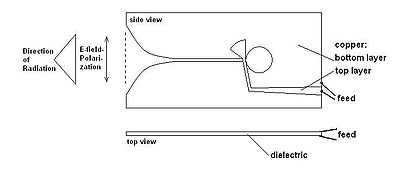Vivaldi antenna
This article needs additional citations for verification. (September 2014) |
A Vivaldi antenna is a co-planar broadband-antenna, which is made from a dielectric plate metalized on both sides.

The feeding line excites a circular space via a microstrip line, terminated with a sector-shaped area. From the circular resonant area the energy reaches an exponential pattern via a symmetrical slot line.
Vivaldi antennas can be made for linear polarized waves or – using two devices arranged in orthogonal direction – for transmitting / receiving both polarization orientations.
If fed with 90-degree phase-shifted signals, orthogonal devices can transmit/receive circular-oriented electromagnetic waves.
Vivaldi antennas are useful for any frequency, as all antennas are scalable in size for use at any frequency. Printed circuit technology makes this type antenna cost effective at microwave frequencies exceeding 1 GHz.
Advantages of Vivaldi antennas are their broadband characteristics (suitable for ultra-wideband signals [1]), their easy manufacturing process using common methods for PCB production, and their easy impedance matching to the feeding line using microstrip line modeling methods.
The MWEE collection of EM simulation benchmarks includes a Vivaldi antenna.[2][3][4][5][6][7]
References
- ^ De Oliveira, A. M.; Perotoni, M. B.; Kofuji, S. T.; Justo, J. F. (2015). "A palm tree antipodal Vivaldi antenna with exponential slot edge for improved radiation pattern". IEEE Antennas Wireless Propag. Lett. 14: 1334. doi:10.1109/LAWP.2015.2404875.
- ^ "Vivaldi Antenna". CST Computer Simulation Technology.
- ^ "The 2000 CAD Benchmark". Microwave Engineering Europe.
- ^ "Design An X-Band Vivaldi Antenna". Microwaves and RF.
- ^ "Characterization of Vivaldi antennas utilizing a microstrip-to-slotline transition" (PDF).
- ^ "Dual-orthogonal polarized Vivaldi Antenna for Ultra Wideband Applications".
- ^ "Vivaldi antenna".
